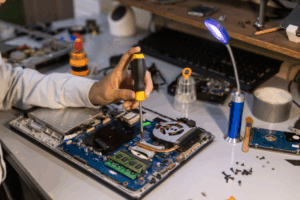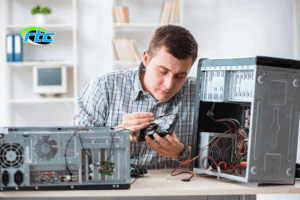If your computer is running slowly, it can be frustrating and time-consuming. Whether you’re trying to get work done, play games, or stream movies, a sluggish machine can quickly derail your plans. Thankfully, there are simple and effective ways to speed up your computer without having to spend a fortune on professional services. In this guide, we’ll walk you through some easy steps to fix common issues and restore your computer’s performance.
At Reliable Telecom, we specialize in computer repair and provide solutions to speed up your device, whether it’s a laptop or desktop. Follow the steps below, and you’ll be back to working efficiently in no time!
Why Is My Computer So Slow?
Before jumping into the solutions, it’s important to understand why your computer may be slow. There are many possible reasons for a sluggish system:
- Too many startup programs: Programs that automatically start when your computer boots can consume valuable resources.
- Outdated software: Running outdated operating systems or apps can lead to performance issues.
- Malware and viruses: Harmful software can slow down your computer significantly.
- Cluttered hard drive: A full or fragmented hard drive can lead to slower speeds.
- Insufficient RAM: If your computer doesn’t have enough random access memory (RAM), it may struggle to perform tasks efficiently.
Simple Steps to Speed Up Your Computer that’s running slowly:
Over time, computers tend to slow down, affecting performance. However, there are simple steps you can take to boost speed and improve efficiency.
Step 1: Clean Up Your Hard Drive:
One of the quickest and easiest ways to speed up your computer is to clean up your hard drive. Over time, your system collects files that are no longer necessary, such as temporary files, system caches, and old documents.

How to Clean Your Hard Drive
- Delete temporary files: Use built-in tools like Disk Cleanup on Windows or CleanMyMac on macOS to remove junk files.
- Uninstall unused programs: Check your installed software list and remove anything you no longer need.
- Empty your recycle bin: Files in the recycle bin still occupy space and can slow down your system.
- Defragment your hard drive (Windows users only): Defragmenting your hard drive can improve its read and write speeds, particularly if you’re using a traditional HDD (Hard Disk Drive).
Step 2: Limit Startup Programs
Many programs automatically launch when you start your computer, and this can significantly slow down boot times. Reducing the number of programs that start up with your computer will speed things up.
How to Manage Startup Programs
- Windows: Open Task Manager (Ctrl + Shift + Esc), go to the “Startup” tab, and disable unnecessary programs.
- Mac: Go to System Preferences > Users & Groups > Login Items, and remove any unnecessary apps from the list.
Step 3: Update Your Software
Running outdated software, including your operating system and applications, can lead to performance issues. Software updates often contain bug fixes, security patches, and performance improvements.

How to Update Your Software
- Windows: Go to Settings > Update & Security > Windows Update and click “Check for updates.”
- Mac: Click on the Apple logo > About This Mac > Software Update.
- Apps: Check for updates for any installed programs by visiting their settings or download pages.
Step 4: Run a Malware Scan
Malware, viruses, and other malicious software can severely slow down your computer. A system infected with malware will experience lag, crashes, and frequent freezes. It’s crucial to run regular scans and remove any harmful software to improve performance.
How to Run a Malware Scan
- Windows: Use Windows Defender or a trusted third-party antivirus program to scan your system.
- Mac: While macOS is less vulnerable to viruses, it’s still a good idea to install a trusted antivirus program to check for malware.
Step 5: Upgrade Your RAM
If your computer is still sluggish after following the steps above, you might need to upgrade its hardware. Adding more RAM (Random Access Memory) can significantly improve your computer’s performance, especially when running multiple programs or dealing with resource-heavy tasks like video editing or gaming.
How to Upgrade Your RAM
- Check your current RAM: On Windows, right-click on the “This PC” icon and select “Properties” to view your system’s RAM.
- Determine the maximum supported RAM: Check your computer’s manual or online specs to see how much RAM your system can handle.
- Install new RAM: If you’re comfortable opening your computer, you can purchase compatible RAM sticks and install them yourself. Otherwise, contact a professional computer repair technician for assistance.
Step 6: Perform a Fresh Install of Your Operating System
If all else fails, reinstalling your operating system can give your computer a fresh start. This will erase all of your files and programs, so make sure to back everything up before proceeding. A clean installation of your OS can remove hidden malware, corrupted files, and other software-related issues that slow down your system.

How to Perform a Fresh Install
- Windows: Go to Settings > Update & Security > Recovery and select “Reset this PC.”
- Mac: Restart your Mac, hold Command + R during startup to enter Recovery Mode, and select “Reinstall macOS.”
Step 7: Replace Your Hard Drive with an SSD
If your computer still feels slow, one of the most impactful upgrades you can make is replacing your traditional hard disk drive (HDD) with a solid-state drive (SSD). SSDs are much faster than HDDs and can greatly improve boot times, load times for apps, and overall system performance.
How to Upgrade to an SSD
- Backup your data: Before replacing your HDD, make sure to back up your important files to an external drive or cloud storage.
- Clone your old drive: Use software like Clonezilla or Macrium Reflect to copy your old drive’s data to your new SSD.
- Replace the HDD: If you’re confident in your technical skills, you can swap out the old drive yourself, or you can seek help from a computer repair professional.
Additional Tips to Speed Up Your Computer:
- Disable visual effects: In Windows, you can turn off unnecessary animations and visual effects to improve speed.
- Use a lightweight browser: If your browser is slow, consider using an alternative like Google Chrome or Firefox, which are optimized for speed.
- Keep your system cool: Overheating can cause your computer to throttle performance. Make sure your computer’s cooling system is working properly and that it’s free of dust buildup.
When to Seek Professional Help?
If you’ve followed these steps and your computer is still slow, it might be time to consult a professional computer repair service. At Reliable Telecom, we can help identify and fix issues that you might not be able to resolve on your own. Whether it’s a hardware upgrade, virus removal, or in-depth system cleanup, our experts have the tools and experience to restore your computer’s performance.
How Reliable Telecom Will Help?
At Reliable Telecom, we understand how frustrating it can be to deal with a slow computer. Our team of experienced technicians is dedicated to providing efficient computer repair services to improve your system’s performance. Whether you need a system cleanup, hardware upgrade, or a virus scan, we offer reliable and fast solutions. Here’s how we can help:
- Thorough diagnostic checks: We will analyze your system to identify underlying issues that may be slowing it down.
- Expert repairs: From malware removal to RAM upgrades, we offer comprehensive services that get your computer back to optimal performance.
- Data protection: We ensure your files are securely backed up before performing any repairs, so you don’t lose your important data.
- Personalized support: Our customer service team is available to answer any questions and guide you through the repair process.
Areas We Serve
At Reliable Telecom, we are proud to offer computer repair services to customers in several areas. We serve both residential and business clients, providing reliable and efficient solutions for all types of computer problems. Our service areas include:
No matter where you’re located within these areas, we are just a phone call or email away. If you’re outside these areas, feel free to reach out, and we can still provide remote support!
FAQs (Frequently Asked Questions)
1. How do I know if my computer needs more RAM?
If your computer slows down when running multiple programs or handling tasks like gaming or video editing, it may need more RAM. Check your RAM usage in Task Manager (Windows) or Activity Monitor (Mac)—if it’s consistently near 100%, an upgrade is recommended. Other signs include frequent freezing, slow app loading, and high disk usage.
2. Why is my computer still slow after a cleanup?
A cleanup removes unnecessary files, but other issues like hardware limitations, background apps, Virus removal, or too many startup programs could still slow it down. Check for these factors and consider a hardware upgrade if needed. Running a system diagnostics test can help identify the exact cause of the slowdown.
3. Can I speed up my computer without upgrading hardware?
Yes! Try these steps:
- Uninstall unused apps
- Disable startup programs
- Clear cache & temp files
- Update software & drivers
- Run a malware scan
Keeping your system optimized with regular maintenance can significantly improve speed and efficiency.
4. How long does a computer repair take?
The time required depends on the issue. Simple software fixes, like removing malware or cleaning up the hard drive, may take a few hours. Hardware upgrades or more complex repairs may take a couple of days. We will always provide an estimated timeline when you contact us.
5. How often should I run a virus scan?
Run a quick scan weekly and a full scan monthly. If your system acts strangely (slowdowns, pop-ups, unknown programs), scan immediately. Having real-time protection enabled can also help prevent infections before they occur.
6. Can you help me with my laptop and desktop?
Yes! We repair both laptops and MacBook, handling hardware fixes, software issues, performance optimization, and data recovery. Our services also include screen replacement and motherboard repair for devices with physical damage or internal component failures.
Conclusion
A slow computer doesn’t have to be a permanent problem. By following these simple steps, you can speed up your computer and improve its overall performance. From cleaning up your hard drive to upgrading your hardware, there are plenty of solutions that can help. However, if you’re still struggling or if the issue is more complicated, don’t hesitate to contact Reliable Telecom for professional computer repair services. Let us help you get back to a fast and efficient computing experience!
Contact Us
If you’re experiencing slow computer performance or need any other computer repair services, don’t hesitate to reach out to Reliable Telecom. Our experienced technicians are ready to help get your computer running like new again!
- Email: help@reliable-telecom.net
- Phone: (772) 233-4404



